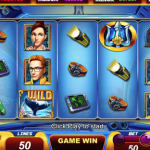The Titans of Modern Gaming: PlayStation and Nintendo Switch
Gaming has evolved into a cultural cornerstone, dominated by powerhouse consoles like the PS4, PS5, and Nintendo Switch. Each platform offers distinct experiences. The PlayStation legacy, spanning from the PS4’s massive install base to the PS5’s cutting-edge tech, redefines console performance. Sony’s ecosystem thrives on cinematic exclusives, lightning-fast SSDs, and immersive features like haptic feedback. Backward compatibility ensures PS4 libraries remain vital, while PS5 exclusives push visual boundaries. Meanwhile, Nintendo Switch carves its niche with revolutionary hybrid design. Play docked for big-screen adventures or undocked for true portability – this flexibility, combined with iconic franchises, makes it indispensable. The Switch’s unique appeal lies in local multiplayer joy and family-friendly titles, contrasting PlayStation’s focus on high-fidelity, online-centric experiences. Both platforms dominate living rooms globally, yet cater to different playstyles and demographics, proving the market has room for multiple giants.
Understanding hardware differences is crucial. The PS5 leverages custom RDNA 2 architecture and ray tracing for unparalleled realism, while its DualSense controller creates tangible in-game sensations. The Nintendo Switch, though less powerful, excels through innovation: detachable Joy-Cons enable spontaneous co-op, and exclusive IPs like Mario and Zelda drive sales. Market positioning is equally strategic. PlayStation targets core gamers seeking blockbuster narratives and competitive online play, often through services like PlayStation Plus. Nintendo prioritizes accessibility and shared experiences, appealing to casual players and families. This divergence fuels healthy competition, pushing both companies to refine their offerings. Whether you crave the raw power of a PlayStation or the adaptable charm of a Switch, today’s landscape delivers exceptional choice.
Pokémon’s Enduring Power: From Games to Coveted Collectibles
The Pokémon franchise transcends video games, embedding itself in global pop culture for over 25 years. While core RPGs on Nintendo Switch like Scarlet & Violet continue the journey, the Pokémon Trading Card Game (TCG) has exploded into a parallel phenomenon. Collectors and players alike chase rare cards, turning booster boxes into sought-after commodities. Sets like Mega Symphonia Booster Box and Mega Brave Booster Box represent specific eras of the TCG, often featuring powerful Mega Evolution Pokémon and stunning full-art designs. These boxes aren’t just game components; they’re potential treasure troves holding cards worth thousands. The thrill of the pull, combined with strategic gameplay, sustains a vibrant community. Understanding set mechanics, card rarities (like Secret Rares or Alternate Arts), and market trends is essential for serious collectors. For the latest releases and competitive staples, many enthusiasts turn to trusted retailers like Pokemon TCG specialists.
Recent years saw unprecedented TCG demand, driven by nostalgia, influencers, and investment potential. Limited print runs, especially for special sets or Japanese imports like the PRB-02 Booster Box, create scarcity, amplifying collector frenzy. PRB-02, part of Japan’s “Peerless Fighters” set, introduced sought-after Trainer Gallery cards and powerful Battle Region Pokémon. Similarly, Mega Brave focused on potent Mega Evolutions like Mewtwo and Rayquaza, while Mega Symphonia offered a diverse range of Megas alongside popular Fairy-type support. These boxes encapsulate specific TCG metas and artistic styles, making them historical snapshots. Navigating this market requires diligence – identifying reputable sellers, recognizing counterfeit risks, and understanding grading (PSA, Beckett) for value preservation. Whether for competitive deck building, completing a master set, or securing appreciating assets, Pokémon TCG remains a dynamic intersection of play, passion, and profit.
Case Study: The Ripple Effect of Premium Booster Box Launches
The release of premium Pokémon TCG booster boxes demonstrates the intricate dynamics between scarcity, hype, and community engagement. Examine the launch of the Mega Symphonia Booster Box and Mega Brave Booster Box. These sets, focusing on the popular Mega Evolution mechanic, generated immense pre-launch buzz. Distributors allocated limited stock to retailers, creating immediate scarcity. Savvy collectors pre-ordered months in advance, while casual players faced inflated secondary market prices shortly after release. This scarcity wasn’t accidental; it’s a calculated aspect of the TCG economy. The allure of pulling high-value chase cards, like a Rainbow Rare Charizard or a textured Full Art Mewtwo EX, drives box openings. However, sealed booster boxes themselves often become appreciating assets. Historical data shows boxes like early Black & White era or XY Evolutions skyrocketing in value years later, turning initial purchases into long-term investments.
Contrast this with the market entry of a Japanese set like the PRB-02 Booster Box (Peerless Fighters). Japanese sets often feature exclusive artwork, earlier card releases, and different rarities, making them highly desirable internationally. The PRB-02 box, introducing cards like the powerful Origin Forme Dialga VSTAR and stunning Character Rares, caused significant waves. International buyers, unable to easily purchase Japanese products at MSRP, relied on importers and specialist stores. This demand surge highlights the global nature of the hobby and the premium placed on Japanese exclusivity. Real-world examples abound: the infamous 2020-2021 Pokémon TCG boom saw even recent sets like Shining Fates or Evolving Skies selling for multiples of their RRP. Limited reprints, influencer box breaks, and crossover appeal from video games (Pokémon Legends: Arceus synergized with the Dialga/Palkia focus in PRB-02) all converge to make premium booster box launches pivotal events, influencing secondary markets, local game store traffic, and collector strategies worldwide.

